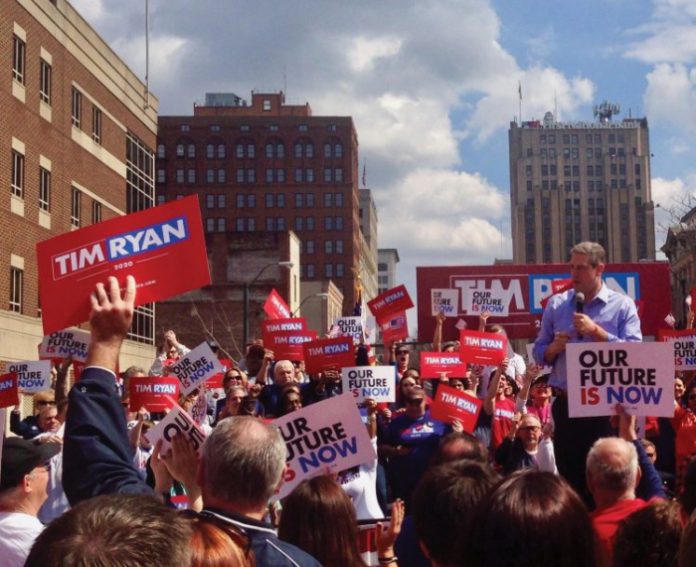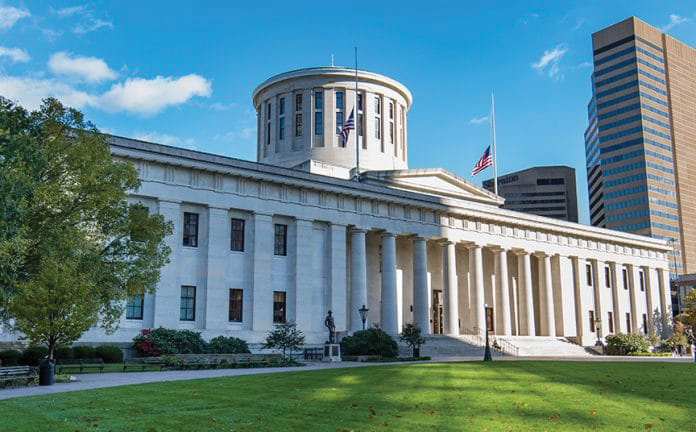
The Ohio Republican Party’s 2023 legislative calendar is off to a flying start. On March 28, they began hearings on a proposal to require a 60 percent supermajority to pass constitutional amendments. Currently, only a simple majority is required. If three-fifths of both chambers support the proposal, it moves to the ballot.


That same day, Ohio Republicans submitted Senate Bill 92, which would resume August elections, which were eliminated after the passage of House Bill 458 – a bill previously supported by Republicans and signed by Ohio Gov. Mike DeWine. The new bill is widely viewed as an effort to head off a constitutional amendment enshrining abortion rights in the Buckeye State and thwart any efforts at redistricting reform.
On the economic front, House Bill 1, sponsored by Rep. Adam Mathews (R-Lebanon) aims to institute a flat 2.75 percent income tax and cut property taxes.
Critics say the measure would reduce funding to libraries and parks and substantially impact school districts, which rely on property taxes. The Columbus City Schools Board of Education estimates that the district could lose $5.5 million in funding in the first year alone if the bill passes. HB1 is a top priority for House Speaker Jason Stephens.

The state’s conservative legislative agenda is a sign of the continued growth of Republican power and a declining Democratic Party. Currently, Republicans control the offices of governor, secretary of state and attorney general. They are the majority in both chambers of the legislature. Partisan gerrymandering has played a role in increasing Republican power and has allowed them to build supermajorities in the legislature. However, the Democratic Party’s decline goes deeper than Republican success in creating gerrymandered congressional maps.
Democrats in Northeast Ohio, backed by a strong labor vote, once represented the heart of the state’s New Deal-era coalition. This proved especially true for the Mahoning Valley, according to Bill Lawson, director of the Mahoning Valley Historical Society. “We went from a Republican stronghold in Mahoning County to a Democratic stronghold in less than a decade. That was driven primarily by the Great Depression and the labor movement,” Lawson said.
Today the party has trouble staying competitive at all, said Paul Sracic, professor of political science at Youngstown State University. “You have this consistent performance over time where Democrats cannot win Northeastern Ohio – with the exception of Cuyahoga County.”
Nine of the 12 counties in Northeast Ohio are now red, Sracic noted. The Mahoning Valley is no exception to this trend.
U.S. Rep. Tim Ryan, who ultimately lost the Senate race to Republican J.D. Vance last November, lost his home county of Trumbull 56 percent to 46 percent. Elsewhere, DeWine won Mahoning County by 30 points and State Sen. Michael Rulli (R-Salem) defeated his Democratic opponent Bob Hagan by over 30 points.
State Rep. Lauren McNally’s victory and Mahoning County Commissioner Carol Rimedio-Righetti’s narrow win proved to be rare bright spots for local Democrats. Mahoning County Democratic Party Chairman Chris Anderson did not respond to requests for comment.
Mark Alberini, recently elected chairman of the Trumbull County Democratic Party, has watched the party’s fortunes decline there. The November midterm election proved to be no exception.
“Ohio, from a Democratic standpoint, fared much better than Trumbull County did,” Alberini said. “We picked up a seat. Nationally, we didn’t see what happened in Trumbull County.”

After narrowly defeating Democrat Mike O’Brien for the Trumbull County Commissioner’s seat last November, Republican Denny Malloy told WKBN that politics had changed in Trumbull County. “We’ve moved more conservative. We’re not going to embrace the ways of the Democratic Party left and right coast, and we are Midwest people with good moral values, and we voted that way today.”
During the fall election, local Republicans ran on a more national platform and focused on “culture war” issues, according to Alberini, which included the global supply chain crisis, the war in Ukraine and cultural issues in America writ large. “At the state level, they’re going to have zero impact on anything they ran on,” he said. “That’s even magnified more at the county level.”
Alberini said he wants a party that can stay “on message,” and he sees that message as one focusing on issues affecting workers. “I think that Democrats are somewhat apologetic, and they have zero reason to feel that way. We’re for the working class. We’re for the workers.”
John Russo, former co-director of the Center for Working Class Studies at Youngstown State University and visiting scholar at the Kalmanovitz Initiative for Labor and the Working Poor at Georgetown University, is far less sanguine about the state of the Democratic Party in Ohio.
“I think they’re lost. There’s no bench. The local Democratic Party is weak. I think the Ohio Democratic Party is on life support.”
In decades past, the strength of the Democratic Party in Northeast Ohio “countervailed” the conservative vote in the state’s southern counties, Russo explained. “Youngstown and Northeast Ohio consistently supported Democrats through 1996.” He traces the party’s decline to the Clinton administration’s move away from unions and working-class issues to more of a focus on upper income voters in the professional classes.
“The Democratic Party doesn’t pay enough attention to working-class issues, period,” Russo said. He emphasized a few exceptions in Ohio, including former State Rep. Robert Hagan, former U.S. Rep. Tim Ryan and Sen. Sherrod Brown, who is the last statewide Democratic politician of note.
The state party’s lack of finances, which became a headline issue during Ryan’s campaign for Senate, along with the lack of viable younger candidates running for state office, are two of the biggest disadvantages Democrats in the Buckeye State face, Russo noted.
“I think Bobby Hagan getting into that race with Rulli was fascinating for me, because I knew for a fact that he was going to lose, but he basically had to carry the flag.”
Problems recruiting candidates go beyond the Mahoning Valley. The Ohio Democratic Party failed to contest four state Senate seats held by Republicans in 2022 and didn’t run candidates in 19 House districts.
Russo, who predicted a victory for Joe Biden in Ohio in 2020, sees continuing Republican dominance as perhaps the end of the state’s status as one divided more or less equally between Republican and Democratic support. “Ohio is still a purple state. How long that’s going to last, I don’t know.”
Vladimir Kogan, associate professor of political science at the Ohio State University, echoes many of Russo’s points. “Given Ohio’s historical purple state status, the weakness of the Democratic Party is really striking,” he said. “You would not expect a purple state to have such a weak party and such an atrocious record in statewide races, which you can’t blame on gerrymandering.”
Many of the party’s problems are compounding, Kogan said. As the Democrats’ track record of electoral defeats mount, donors have no incentive to give, as few except the party to win races and wield power. Fewer electoral victories mean fewer chances to build a “pipeline” of talent for the party to groom for higher offices, he added.
Perhaps most startling, organized labor, long a base of Democratic support, is also funding Republican candidates. The AFL-CIO supported former Ohio House Speaker (and now convicted felon) Republican Larry Householder and House Bill 6, which was a $1 billion bailout of Ohio’s two nuclear power plants. AFL-CIO affiliated unions represent workers at both plants.
“They ultimately know that’s who is going to be making policy. They want to gain access and build relationships there,” Kogan emphasized. By supporting friendly Republicans, labor might be angling to avoid another effort to pass “right-to-work” legislation, he suggested, something the Kasich administration attempted.
The culture wars and the increasing salience of social issues have also hurt the party outside of Ohio’s large cities, Kogan said. “We are very much a state divided by geography between urban and rural, and you cannot win a statewide majority just by relying on urban blue areas.”
Republicans and Democrats did find some common ground earlier this year when a bipartisan coalition defeated an effort by Derek Merrin (R-Monclova) to become Speaker of the House. Merrin has supported a “right to work” bill for public employees.

One of the more prominent voices for progressive politics in the state has been critical of both parties. Morgan Harper, a Columbus-based lawyer and community organizer, has been referred to as the “AOC of the Midwest” [a reference to U.S. Rep. Alexandria Ocasio-Cortez]. She unsuccessfully challenged Tim Ryan during the Senate primary race in 2022, representing a left alternative to the former congressman’s more centrist messaging.
Even in Columbus, where the economy has outpaced the rest of the state and the Democratic Party has remained strong, voters, and especially young voters, have become skeptical of both parties, Harper said.
“I think there’s a feeling among young people in Ohio, and other different types of people, that typical politicians haven’t served us all that well.”
Harper is the co-founder of Columbus Stand Up!, a direct service and grassroots organizing nonprofit. She’s been involved in political and community organizing throughout the city and points to the importance of engaging local communities outside of election years, something the Democratic Party, she said, has often failed to do.
“You cannot just show up to people, especially some of the marginal voting populations – including young people – and expect that they’re just going to jump and show up for you.”
Like Mark Alberini, Harper thinks messaging is a key issue for Democrats. “I do think it starts with a message, having a message that meets people where they’re at, which is a high point of frustration.”
Mirroring Sherrod Brown, who has critiqued the role of corporate power repeatedly and built a reputation as a populist Democrat, Harper sounds closer to a New Deal-era Democrat.
“We need to start focusing on economic populist messaging and policies,” she said. “We need to be serious about taking on corporate power that is screwing over the average Ohioan.”
In the wake of Ryan’s defeat in November, Harper feels that voters have delivered the Democrats a tough message.
“They’re looking for something different. And that even a weak candidate like J.D. Vance, who really was bought and sold by Trump and Silicon Valley millionaires, was able to beat us should be a wakeup call.”
***
Metro Monthly is a local news and events magazine based in Youngstown, Ohio. We circulate throughout the Mahoning Valley and offer print and online editions. Be sure to visit our publication’s website for news, features, and community events. Office: 330-259-0435.
© 2023 Metro Monthly. All rights reserved.




